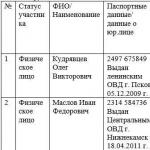Determination of key performance indicators kpi. What is KPI in personnel management. Main KPI indicators
KPI (Key Performance Indicators) - “key performance indicators”, but more often translated as “key performance indicators”. KPI is one of the tools with which you can analyze how effectively staff works to achieve the company's goals.
KPI indicators are often used by larger companies (not where the owner, director, seller and loader are the same person), but on the contrary, when the company has a large number of employees and branches. The use of “kipiai” greatly simplifies monitoring the performance of all departments of the company. Having key performance indicators gives us the opportunity to manage the process and make changes to it. Set goals for staff and motivate them to achieve them.
Let's look at an example of key performance indicators. You are the owner of a large household appliances store and you have 12 sales managers on your staff. The performance of each manager for the month can be assessed according to the following criteria:
- what % of clients with whom the manager communicated made a purchase;
- average customer bill;
- fulfillment of the sales plan (for example, the minimum monthly limit is 350,000 rubles, and the manager’s salary will depend on the percentage by which he exceeds the plan);
If, for example, you need to sell blenders of a certain model, you can set a plan for each manager of at least 5 units; if more, then for each “extra” unit the seller receives 3% of its cost. Thus, the goal is achieved to sell a certain product and motivate managers to do so. As practice shows, the optimal number of KPI criteria for one employee is from 5 to 8.
2. Types and principles of KPI
Types of key performance indicators:
- Result KPI – quantitative and qualitative indicators of results;
- Cost KPI – amount of resource expenditure;
- KPI of functioning - how well the execution process corresponds to the established algorithm;
- Performance KPIs are derived indicators that characterize the relationship between the result obtained and the time spent to obtain it;
- Efficiency KPIs (performance indicators) are derived indicators that characterize the ratio of the results obtained to the expenditure of resources.
There are principles to follow when developing key performance indicators. The costs of measuring performance indicators should not exceed the management benefits of using the indicator. You won’t hire a person who will count the number and duration of the manager’s calls; the result will not justify the costs. For a more accurate result and the possibility of comparison, indicators should be measurable and as simple as possible, understood equally by each department, in order to avoid misinformation. And, most importantly, KPIs are necessary; if we do nothing based on the results of their measurement, then in this case they are meaningless.
3. Pros and cons of KPIs
The main advantages of KPI include:
- fairness, transparency and comparability of results (management and staff see who works and earns how much);
- adjusting the employee’s work according to the lagging indicator;
- involvement of personnel in achieving the goals of the enterprise;
- quality control of performance of duties.
Despite all the positive aspects of the KPI system, it is not universal. Not all indicators in the work of personnel can be measured quantitatively, and therefore each business has its own ways of assessing efficiency, and finding them will require a large investment of time, labor and finances.
4. How to calculate KPI. Example
There is no single formula for calculating KPIs, since each company has its own specifics and, therefore, its own “kipiai”. Let's look at the example of calculating the salary of a sales manager, taking into account his KPIs in the Kotelok online store.
Rate 7,000 rub. +2% from personal sales (800,000*0.02=16,000 rub.) + bonus for fulfilling the plan for the number of new clients (2,000 rub.) + bonus for fulfilling the enterprise plan (for example, the plan is 100% fulfilled - 5,000 rub. , by 70% - 3,500 rubles) in our case, by 80% - 4,000 rubles. In total, at the end of the month the manager will receive a salary of 29,000 rubles. This counting system motivates managers to sell to existing customers and attract new ones.
5. What are KPIs in sales
In the sales field, the main key performance indicators for the sales manager and sales department are: 1. Sales volume.
The manager is given a plan for a certain period of time (month, quarter, year). For example, in March the manager must make sales of 1,300,000 rubles. 2. Number of sales.
Number of customers who made a purchase (number of receipts). The number of customers who learned about your product are potential buyers. Of course, attracting traffic is the task of marketers, but the seller himself can also influence the flow of customers, for example, through word of mouth.
4. Average check. It is implemented in order to encourage the manager to sell additional products. For example, purchase a heat-resistant glass plate or baking dishes for the oven.
You can develop a KPI system yourself, but this will require a lot of effort and more than one dog to eat. Most large companies still prefer to entrust the construction of a “kipai” system to professionals with extensive experience in this field. If you need help implementing KPIs in your company, please contact us, we will be happy to help!
Kipiai, or key performance indicators, is a unique system that has recently come to Russian business. Today, there is no more reliable method with which to evaluate the efficiency of an enterprise, so the use of this system is practiced not only in Russia, but throughout the world.
Concept of KPI
First, let's fully address the question of what it is - KPI, or key performance indicators.
KPI is a unique system with which you can calculate the performance of each individual employee of the organization. Thanks to such a system, it is possible not only to understand how effective the activities of employees are, but also to motivate them to improve their work skills. The most optimal performance indicators for each individual employee should not exceed the number 5.
To understand how to operate this system correctly, it is necessary to more carefully and deeply study the types of performance indicators, as well as consider examples of KPIs.
Types and groups of KPIs
Kipiai indicators are usually divided into several subgroups, based on the results obtained when calculating a certain area of activity.
- Financial expenses.
- Company productivity, which involves calculating kpi as a percentage. This percentage shows how high the capacity utilization of a particular enterprise is.
- Productivity of the company. This subgroup of KPI performance indicators is based on a comparison of certain data (for example, cost items and revenue for a certain period of time).
- Final calculations, which are based on the quantitative expression of results relating to the activities of company employees.
A key performance indicator is built on several principles. If you do not take them into account, the data obtained will be unreliable. These are the principles:
- All indicators must be measured in quantitative numbers.
- The data obtained must be directly related to the activities of the company.
- The results should not be costly, both in terms of time and resources.
Previously, we looked at the question of what a KPI is, dividing it into 3 small subgroups. However, the gradation does not end there, since this system also has its own varieties. There are two of them in total. These are operational and strategic KPIs. Let's first figure out what kind of operational KPI system this is.
Operating indicators are indicators that can be used to assess the effectiveness of a company’s activities at the moment. Simply put, the data obtained when calculating kpi reflects how well the company’s employees work in the current period of time.
In addition, operational systems help to compare the tasks performed by workers with the conditions that were created for this. Based on the results obtained, the management of the enterprise can assess the quality of the manufactured product, the conditions for its delivery and further distribution.
What is a strategic KPI indicator? Such indicators reflect the performance of a company over a certain period of time. With their help, you can find shortcomings in the work of personnel and adjust their activities for the next period of time (for example, for the next month, quarter, six months, etc.).
In addition to the quality of employee work, financial data can also be processed. Based on the results of the KPI calculation, cash flows are characterized, which help to understand how profitable the organization itself is and how much demand the products produced by it are in.
Areas of application of KPI and its calculation
Since we have figured out what kpi is, or, in simple words, key performance indicators, we need to move on to the next, no less important, question: where and why are they used? And also consider the formula by which they are calculated.
A performance indicator is a numerical measurement of set (and completed) goals and objectives that play an important role in the successful promotion of a business. Thanks to the compiled report, which takes as a basis all the necessary indicators (they were discussed above), the organization’s management has the opportunity to fully assess how the developed plan was implemented, as well as what was achieved over a certain period.
KPIs are used in various areas of business. For each of them there is a list of indicators that are processed, and on the basis of which an indicator is calculated that reflects the efficiency of the enterprise.
Sales area
To increase your wealth, you need to understand what KPIs are in sales and the important role they play. These indicators can be calculated based on:
- financial profit received for a certain period;
- revenue from sales carried out by the company;
- cost of goods produced;
- percentage of low-quality goods;
- amounts of current assets;
- the total cost of all inventories of the enterprise.
KPI indicators in retail trade are based on 5 basic principles:
- percentage of sales for 1 hour or day of operation of a retail outlet;
- the average amount of money paid by the buyer for the goods (this amount is calculated based on punched checks);
- quantity of products sold at one time;
- the ratio of employee salaries to revenue from the sale of goods;
- sales conversions.
Thus, having received all the necessary calculations, you can quickly adjust the work of the staff, significantly increasing the number of transactions carried out, which, in turn, helps to increase the store’s income.
Manufacturing industry
What is the production indicator in production, and on what basis is it calculated? First of all, when calculating the efficiency coefficient, the following is taken as a basis:
- indicators of the average daily consumption of raw materials from which products are made;
- volumes of raw materials consumed and remaining in stock;
- volumes of work in progress;
- employee performance;
- various production costs;
- cost of equipment repair;
- conditions, terms and cost of storage of finished products.
To get the right data, you need to know how to calculate KPIs. There is a special formula for this:
(qf/ qpl)×100%
Now let's decipher the indicators:
- qf – the actual volume of all sales made by the company;
- qpl – sales volume that is just planned to be realized.
The data obtained through this form is the so-called performance criterion.
Examples of KPIs
To fully understand what kipiai is, let's look at some examples of key performance indicators. For a better understanding of the essence, each of the professions that is taken into account in the calculation will be considered separately. The table below indicates not only the type of activity, but also the indicator on the basis of which the efficiency criterion is calculated.
| Number | Job title | Indicator for calculation | Formula for calculation |
| 1 | Head of Marketing Department | The total percentage of the previously developed plan. | The general calculation formula described above. |
| 2 | Marketer | Total percentage of all brands on the market | Calculated based on data from all third party marketing firms. |
| 3 | Chief Accountant | Timely submission of the enterprise income statement to the tax service. | Data received from the tax authority. |
| 4 | Accountant | Total percentage of completed financial transactions | This profession has its own formula for calculating kipiai: (qpsr/qptot) × 100%, where the first indicator in brackets implies the number of financial transactions that were completed on time, and the second – the overall results relating to all payment transactions. |
| 5 | Head of the legal department | The total number of lawsuits won is taken as a basis. | The ratio of the number of won cases to the total number of trials. The result obtained is multiplied by 100%. |
| 6 | Lawyer | The amount of money that was collected from other businesses in favor of the organization where the person works. The amount of money that was saved by the company is also taken into account. | All data from reports compiled by the legal department are taken into account. |
If we again take the example of the KPI of a sales manager as a basis, then with the help of the data obtained after the calculation, the head of the management department will be able to identify not only positive, but also negative aspects in the activities of his subordinates. So, he will know exactly how many necessary calls and meetings the sales manager made, whether they were effective, how many people became regular customers, etc.
If the data obtained does not correspond to the developed plan, this means that the person engaged in this type of activity lacks either knowledge and skills, or perseverance and desire to work.
All the examples of KPIs, or key performance indicators, discussed above fully reflect the essence of this concept. Of course, it’s difficult to immediately understand all these subtleties (especially for a novice businessman). However, it is better to spend a little time on an in-depth study of this important topic than to incur financial losses that could seriously harm the development and successful promotion of the business.
KPI (Key Performance Indicator) is an indicator of success in a certain activity or in achieving certain goals. We can say that KPI is a quantitatively measurable indicator of the results actually achieved.
The term is most often translated into Russian as "key performance indicator", which is not entirely correct: efficiency characterizes the relationship between the achieved result and the resources expended, and other parameters can be measured using KPI. A more correct translation is "Key Performance Indicator".
KPI and BSC
There is a misconception that KPI is directly related to BSC (Balanced Scorecard). However, the developers of BSC - Norton and Kaplan - did not use the term KPI, but used the term measure - “measure”, “meter”.
There is a rather indirect connection between KPI and BSC: in BSC there is a “business process” perspective, which contains goals related to business processes. Indicators of these business processes - KPIs - are often used to measure the achievement of these goals.
The most relevant use of the concept of KPI is. business process management: KPIs are measures of effectiveness, efficiency, productivity of business processes.
The following types of key indicators are distinguished:
- KPI result— how much and what results were produced;
- Cost KPI— how many resources were spent;
- Operational KPIs— performance indicators of business processes (allows you to assess the compliance of the process with the required algorithm for its execution);
- Performance KPIs— derived indicators characterizing the relationship between the result obtained and the time spent to obtain it;
- Efficiency KPIs(efficiency indicators) are derived indicators that characterize the ratio of the results obtained to the expenditure of resources.
When developing process indicators, you must adhere to the following rules:
- The set of indicators must contain the minimum required number to ensure full management of the business process;
- Each indicator must be measurable;
- The cost of measuring an indicator should not exceed the managerial effect of using this indicator.
Algorithm for developing business process indicators
Let's look at the types of key performance indicators using the example of the “Logistics and Technical Support” process of a Manufacturing Company (Fig. 1)
It is most convenient to highlight indicators in relation to the Process depicted in the IDEF0 notation, when the figure shows Inputs, Outputs, Control (process execution rules) and Mechanisms (equipment, personnel). Key performance indicators and performance indicators, being derivatives, when using such a scheme, characterize the process as a whole.
Figure 1. Process "Logistics"
- Applications for the supply of inventory items;
- Inventory assets (materials and materials) - raw materials and materials that must be provided according to the procurement plan or according to supply requests;
- Information on the availability and cost of goods and materials on the market.
- Equipment of workplaces for supply department employees;
- Supply department employees.
Identify control inputs (rules and requirements for process execution)
For example, the process in question may be regulated by:
- “Instructions for the acceptance and storage of raw materials, semi-finished products and materials in the warehouse”;
- “Methodology for selecting suppliers”;
- “Rules for concluding a contract for the supply of raw materials and supplies”;
- "Procurement Plan".
Knowing the result that should be obtained, it is necessary to evaluate it quantitatively - to form result indicators. They can be either simple or calculated (using a formula or other method).
KPI 1— the number of applications for goods and materials (inventory items) completed on time.
KPI 2— % of applications for inventory items completed on time.
KPI 2 = KPI 1 / Z x 100%,
Where Z is the total number of submitted applications for the supply of goods and materials.KPI 3— % of goods and materials of appropriate quality that entered production.
KPI 3 = A / B x 100%
Where, A is the number of goods and materials of appropriate quality entered into production,
B is the total number of goods and materials received into production.Based on the process inputs, cost indicators can be generated.
KPI 4— Costs of purchasing goods and materials (costs of resources).
Based on the process mechanisms, additional cost indicators can be generated.
KPI 5— Costs of carrying out activities (costs of personnel and equipment).
The correctness of the process, in addition to the cost indicators for carrying out the activity, is also reflected by the performance indicators.
KPI 6— The number of failures to submit a draft budget to the financial department during the year.
Performance indicators are calculated as the ratio of the result obtained to the time.
Performance indicator KPI 7 can be the average number of orders processed by the purchasing department per day.
KPI 7 = C/r
Where C is the number of processed applications per month,
r — Number of working days in a month.Calculation of key performance indicators is carried out on the basis of pre-allocated KPI results and KPI costs. Efficiency indicators, therefore, act as integral characteristics of activity.
Example:
An indicator of enterprise production efficiency KPI 8 You can consider the cost of completing one application. This indicator is calculated using the following formula:KPI 8 = KPI 5 / KPI 1
Where KPI 1 is the number of applications for inventory items completed on time,
KPI 5 - Costs of carrying out activities.
Identify the process and its result.
For example,
The process “Material support” is the result of “Useable inventory items”.
Identify input-resources (resources processed in one cycle of the process) and input-mechanisms (resources that ensure repeated execution of the process - equipment, personnel).
For example,
Inputs-resources of the Logistics Process:
Input mechanisms of the process under consideration:
Using this principle (the ratio of costs to results obtained), it is possible to calculate both production efficiency indicators and project efficiency indicators or management efficiency indicators.
Practical application of KPIs
Use in the planning and control cycle
Since KPIs are measures of results and costs, they can be used when planning and monitoring activities as elements of a plan.
Indicators whose values can serve as plan elements for the Logistics Department:
- % of timely fulfillment of requests for inventory and materials - 99%;
- % of goods and materials of appropriate quality entered into production - 100%.
After the activity is carried out, the actual values of the indicators are measured and recorded. In case of serious deviations of actual values from planned ones for the worse, it is necessary to conduct an analysis of activities and develop corrective measures.
Benefits of using a KPI system c. ordinary activities of the company: planning and analysis of activities are carried out on the basis of the results that the business system needs. All indicators are not invented in the abstract, but “originate” from a process that consolidates the activities necessary for the system. If planning occurs on its own, in isolation from real activities, then often the choice of indicators and their target values does not contribute to achieving the main goals of the organization, but is arbitrary and not always justified.
Staff motivation
When implementing KPIs, the motivation system becomes clear and transparent: since planned and actual values are recorded, it is clear to the manager why and how to motivate the employee. He, in turn, understands well under what conditions and what reward he will receive, and for what he will be punished.
Head of Procurement Department:
- Rewarded for successful achievement of planned efficiency and effectiveness indicators;
- Deprived of bonuses for failure to meet performance indicators (missing the deadline for submitting the draft budget to the financial department);
Thus, thanks to the KPI system, the company rewards the employee for obtaining the results it needs, and the employee is interested in obtaining results on an equal basis with the company.
To stay afloat and make a profit, a business must operate with maximum efficiency. Just literally two decades ago, no one thought about how efficiently a particular enterprise, leader, manager or mechanic worked. The main thing is that it makes a profit. But now the approach has changed. You've probably heard about key performance indicators KPI. What it is and why is such a system needed? Let's look at this in this article.
KPI - what is it?
The performance assessment system appeared in Russia literally five years ago and is still rarely used anywhere. It is mainly used in IT and other modern industries. Let's consider, what is KPI and why this assessment system is needed.
KPI is a key indicator of personnel or enterprise performance
KPI stands for Key Performance Indicator, which translated into Russian means key performance indicator. This system is a set of several indicators that evaluate the performance of each employee at the enterprise. Knowing the KPIs for different groups, you can develop average productivity indicators and introduce a system of active motivation for productive employees.
Note:efficiency is a relative indicator. It can be calculated both for a specific employee and for a department, workshop, or enterprise. Effectiveness can be expressed in quantitative results.
It is believed that the optimal key performance indicator for an employee should be no higher than 5. The KPI indicator can be divided into several types:
- By cost item (how much resources were spent in monetary terms).
- According to the productivity item (what percentage of capacity was loaded).
- According to the article of efficiency or ratio of indicators (for example, the ratio of the amount of revenue to the amount of costs).
- According to the final article (general quantitative indicator of productivity).
In practice, it often happens that most of the indicators are intertwined with each other. This allows for collaboration and assessment of a group of specialists or departments, motivating them and constantly achieving better results. Managers and supervisors at all levels must monitor the results, coordinating their actions for maximum efficiency.

KPI is divided into strategic and current
Types of KPIs
Enterprise performance indicators there are two types:
- Strategic. Thanks to this data, you can find out how effectively the enterprise operated over a certain period (the longer the time period, the more accurate the result). Thanks to strategic indicators, you can build action plans for the next period of time. Basically, strategic KPI shows the passage of cash flows, on the basis of which the profitability of production and sales can be calculated.
- Operational. This data shows the real current situation in the company, division, department. Thanks to these values, it is possible to adapt the tasks or goals of the enterprise to dynamic conditions. Using this KPI indicator, you can evaluate the efficiency of logistics, production organization, sales of manufactured goods, etc.
Why is all this needed?
Using the KPI system, you can realistically evaluate and measure the rate of achievement of goals and tasks assigned to a specialist. By calculating all the values and indicators, you can evaluate the effectiveness of your work based on the results achieved and compare them with the planned ones. You can also calculate whether the planned indicators for a specialist/department/enterprise were calculated and compiled correctly. Numerical values help to correctly build strategy and tactics for the future, assessing the real result, not the imaginary one.
Note:the key indicator is tied solely to the result. If some parameters do not affect it in any way, then they can be freely discarded.
KPI was developed based on two ideologies:
- Target management of an organization or department (movement from goal to goal).
- Full control over the goals set and their revision under certain conditions.

Thanks to KPI calculations, you can properly motivate your staff
The very idea of KPI allows not so much to evaluate personnel, but to draw up real plans and anticipate the results of the enterprise’s activities. It is beneficial for everyone: ordinary employees are engaged in routine, while striving to complete the tasks assigned to them, and not scatter themselves and delay the result. Criteria for assessing the performance of other personnel allow him to be motivated: the more tasks are completed, the higher the salary or bonus. Managers benefit when tasks are resolved on time and not scattered among employees. the enterprise benefits because it makes a profit and can make realistic plans for the future based on numerical values rather than empirical ones.
At the moment, the KPI system is considered the most accurate and profitable. It allows you to motivate and stimulate staff and evaluate the activities of managers at any level.
KPIs in production
- Consumption of raw materials per day.
- Volume of raw materials in warehouses and in unfinished form.
- Real labor productivity.
- Costs of storing finished products.
- Amount of other expenses.
- Required amounts for repairs and maintenance of equipment.
KPIs in trade
To calculate key performance indicators in sales you need to know:
- Revenue volume.
- Real cost of production.
- Total profit from sale.
- Possible defect rate.
- The total cost of products in stock.
- The total amount of current assets.

Be sure to use KPI for planning and strategy development
KPI Examples
In order to understand, let's give examples of key performance indicators KPIs for various categories of employees.
The main responsibility of the company's top management is to create a strategy, determine the goals and objectives of the enterprise. The implementation of these goals rests on the shoulders of employees from structural divisions. A company's growth can be jeopardized if information is poorly shared between employees and management. This is mainly due to information overload of management and the inability to rationally assess the situation in work positions. This, in turn, affects the quality of control over the actions of personnel and the implementation of the strategy.
Impact of KPIs on the company
If the staff does not have specific strategic goals, and there is also no sufficient motivation, this leads to the fact that employees are not able to determine the right course and are not able to act for the benefit of the company's development. This inconsistency often leads to waste of company resources on tasks that are secondary. Such problems arise quite often, and many businesses around the world suffer from them.
It is difficult to call a self-sufficient enterprise strategy. Management's aspirations are to achieve goals by setting tasks for personnel, as well as quality control over the quality of work performed. In the chain of elements that are necessary to realize these goals, which constitute the management cycle, there are two elements:

That is why many modern entrepreneurs are interested in KPI (key performance indicators), what it is and how it can help in management. After all, the weak link in the chain shown above is, in fact, the connection between management and staff. If there are failures in its work, then decisions will be made taking into account information that is incomplete. According to some managers, the guarantee of the correctness of their decisions depends on the amount of information collected. But in this case, this is a wrong opinion, since the time required to evaluate information increases, and its quantity is not at all responsible for its quality.
Management Tools
Any management needs a tool that allows them to obtain high-quality and adequate information for decision-making. Western companies have long been using key performance indicators and a balanced scorecard for this purpose.
KPIs are considered a system of indicators (financial and non-financial) that have an impact on the qualitative and quantitative change in the result of personnel work or the result that is expected. It includes the coefficients of each controlled object, as well as the methodology for their evaluation. This allows you to focus on achieving strategic goals, based on an assessment of the organization's performance. 
The assessment of key performance indicators is precisely the tool that can show how well management is carried out in relation to the results relative to the set goals, taking into account the cost and position of the company in the market. It is worth keeping in mind that this tool can facilitate the decision-making process of management thanks to complete and high-quality information, but it cannot solve serious systematic problems of the organization. This technique does not provide ready-made solutions, it only identifies the area in which the problem arises.
The transition to new methods of progressive company management is justified by the fact that old methods, including increasing the scale and pace of production, as well as improving product quality, do not create the necessary competitiveness. Thanks to modern management tools, an organization can quickly respond to any change occurring in the market. 
The main objective of the KPI system together with the balanced scorecard is to move the company into a comprehensive set of necessary indicators that can highlight the main elements of management and measurement. Thanks to this set, an organization strategy is formed that is able to include all the necessary qualitative and quantitative characteristics in order to promptly inform workers about the factors that influence present and future success. Having formulated the results that should be achieved, the organization not only defines the goal, but also works on the conditions that allow it to be achieved better and faster. 
It is not the amount of information that is important, but its objectivity, accuracy and relevance in order to correctly carry out all the necessary calculations. The concept of the balanced scorecard is that traditional financial and economic indicators are not enough for the success of a strategy. To solve problems, it is necessary to better balance key performance indicators, taking into account various planes, in order to control the factors that influence these indicators. You should not pay much attention to past achievements; you should evaluate future results. If you focus indicators on only one area of activity, this will undoubtedly have a bad effect on the final result.
System implementation
To implement a system in an enterprise, there are certain steps that must be performed sequentially. Violation of this sequence can negatively affect the final result.
The first stage is the formation of a strategy
A clearly formulated strategy should describe the main steps to achieve the desired results and goals. It needs to be broken down into specific initiatives, with tasks assigned to individual departments of employees. Thanks to this, significant savings occur not only in money, but also in time.
The second stage is identifying key factors
Here it is necessary to determine the most important factors, or rather, the parameters of aspects of economic and economic activity that have an impact on the implementation of the assigned tasks and the implementation of the strategy. These factors have a significant impact on success.
Stage three – key performance indicators
Here the activities necessary for the strategy to be successfully implemented are determined. KPIs are used as a tool to determine them. It is worth highlighting only the most sensitive of them, without using secondary indicators. They should be stimulating for staff. Among the main requirements for the system of key performance indicators are:
- Clear limits on the number of indicators.
- They must be uniform for the entire company.
- Possibility of obtaining a digital format of the indicator.
- It must be directly related to the factors influencing success.
- Metrics should motivate employees to meet the goals required by the organization.
Key performance indicators: examples
Let's take, as an example, a well workover shop. The strategic goal for this organization will be to increase the level of product production, which will be expressed in well production and reduce the factors that provoke the loss of the product and reduce its cost. In this regard, KPIs should be set so that they reflect not only the goals of the company itself, but also address issues regarding a specific division. If repairs are carried out, the well’s operation will be stopped, therefore, it is worth considering the costs caused by the shutdown. 
The structure of key performance indicators for a given division may have the following structure:

Thus, using KPIs (key performance indicators), examples of which are discussed above, employees are encouraged to reduce costs and increase oil production. This not only corresponds to the overall goals of the company, but also affects the quality of work of a particular department.
The fourth stage is working with a balanced scorecard
This stage involves the development of a generalized system that includes financial and non-financial indicators. This takes into account both the object of control and the assessment of factors influencing the overall picture of the enterprise’s performance.
Fifth stage – selection of a technical solution for implementing the tool
At this stage, the data source through which the indicators will be filled is determined; it must satisfy all the conditions for the reliability of the information received. It is necessary to first create a strategy that allows you to implement a new management tool. Decide on goals, taking into account how positively they will affect the state of the company. It is also necessary to configure the information flow in order to correctly calculate all indicators. There are still many points necessary to achieve the main goals and objectives of the organization, which key performance indicators will help to cope with.





